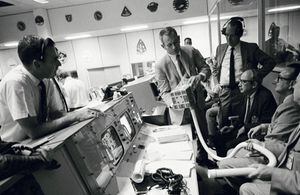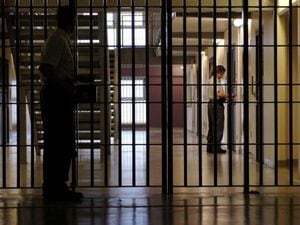Apollo 13 – Wednesday, April 15
WEDNESDAY, APRIL 15, 1970

.......
As if the crew of Apollo 13 did not have enough to think about, they were now in danger of being suffocated.
They had taken to their "lifeboat," their lunar lander, called Aquarius, which was keeping them alive after an explosion during their journey to the moon had crippled the rest of their spacecraft.
The good news was that by Wednesday, April 15, 1970, they were travelling in the right direction, back towards Earth, their moon mission abandoned.
The stricken spacecraft had been grabbed by the gravitational field of Earth which was pulling them back towards home at an ever-increasing speed.
Aquarius, their delicate and lightweight lunar module, with wafer-thin walls, had been their salvation. It had its own batteries, whereas the rest of the spacecraft relied on power generated by fuel cells in the service module which had been rendered useless by the blast, and for all the good it was now doing might as well be jettisoned into space.
The reason it wasn't was that this wasn't the time to be experimenting with entirely new spacecraft configurations, and also left in position it protected the vital heat shield of the command module Odyssey. If the heat shield got damaged, all the efforts would be for nothing, as Odyssey and the astronauts inside would burn up on re-entry to the Earth's atmosphere.
The gravity of the situation had become ever more apparent to both crew and the mission controllers at Houston in the immediate aftermath of the explosion on April 13 as they watched in alarm as electricity drained away.
Under normal conditions it would have taken at least two hours to go through the checklist to activate Aquarius. Instead it was activated in minutes and pressed into action for its new lifeboat role, which was something astronauts had discussed but never practised.
The spacecraft was wreathed in a field of debris from the explosion, which in the vacuum of space hung around and was a major problem because it meant the crew could not take navigational sightings of the stars.
As Eagle had been to Apollo 11, Aquarius was to Apollo 13. In other words, it was the part of the spacecraft which would have landed mission commander Jim Lovell and its pilot Fred Haise on the moon, and then its ascent stage would have reunited the pair with Jack Swigert in the spacecraft waiting in lunar orbit.
So the mission profile for Aquarius involved being the short-lived home for two astronauts. Yet now it was being asked to sustain all three astronauts, and for twice the expected time.
Again, there was some good news. There was more than enough oxygen for the astronauts, so there was no risk of running out. However, what was causing alarm was that levels of carbon dioxide were rising, from their exhaled air.
Aquarius, the lunar module, or LM (pronounced "lem" in transmissions), was equipped with two canisters of lithium hydroxide to clean the cabin air. They were enough to handle the carbon dioxide output of two astronauts for about 30 hours, but not three astronauts for at least four days.
The crew of Apollo 13 now faced the prospect of fatally gassing themselves with their own breath.
There were plenty of lithium hydroxide canisters in Odyssey, the abandoned command module. But they were of the wrong size and shape to fit to the lunar module's environmental control system.
Engineers on the ground sweated over the problem, and what happened next had overtones of an edition of the children's show Blue Peter. They drew up a plan to scavenge for bits and pieces which they knew were available in the spacecraft, like suit hoses, cardboard, plastic storage bags, and tape, and radioed instructions to the astronauts on how to use them to construct makeshift filters and connect them up.
This the astronauts did. The filters worked. Another problem solved.
There was work to do too. For some reason they had drifted slight off course, so were going to have to make a mid-course correction, which was easier said than done because with no guidance system or computer to help him, how would Jim Lovell be able to orientate the spacecraft correctly?
Mission control worked on it. Get the sun shining directly through the lunar module's overhead window, the Earth directly ahead, make a few fine adjustments, and...
Not for the first time, improvisation and ingenuity found a way.





